Playable characters:
64: 01–04 (Starting Roster 1) | 05–08 (Starting Roster 2) | 09–12 (Unlockable Fighters)
Melee: 13–17 (Starting Newcomers) | 18–22 (Unlockable Fighters 1) | 23–26 (Unlockable Fighters 2)
Brawl: 27–31 (E3 2006) | 32–39 (Smash Bros. DOJO!! 2007) | 40–44 (Smash Bros. DOJO!! 2008)
For 3DS and Wii U: 45–49 (Pre-Smash Direct) | 50–55 (Smash Direct and E3 2014) | 56–59 (Remaining Roster) | 60–63 (DLC Fighters)
Ultimate: 64–69 (Initial Release) | New Echo Fighters | 70–75 (DLC Fighters 1) | 76–82 (DLC Fighters 2)
Mii Costumes
Individual Characters: Joker | Sephiroth
Non-playable characters:
Poké Ball Pokémon | Assist Trophies | Enemies | Bosses | Stage Characters | Others
This page lists notable non-playable characters in the Super Smash Bros. series who are tied to specific stages, including hazards and stage cameos. Beware of spoilers.
Stage Hazards
N64
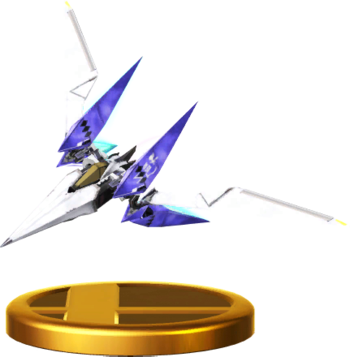
The trademark fighter ships of Star Fox. These effective aircraft can serve as temporary platforms on Sector Z, Corneria, and Venom, but the former two stages also shoot lasers that can cause a potentially large amount of damage.
- Energy Weapon: Their main means of attack is firing powerful laser beams.
- Helpful Mook: They can be used as platforms, though you have to be careful about not having it fly off the stage with you on it.
- Space Fighter: Small, agile one-man spaceships that zoom around in space-themed stages and shoot lasers everywhere.
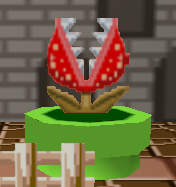
Plants and members of Bowser's army who tend to make their homes in pipes. They pop out of them to try and take a bite out of Mario and co. In the original Super Smash Bros., they appear as stage hazards on the unlockable Mushroom Kingdom stage. A Piranha Plant was later Promoted to Playable in Ultimate; for more information on that, go here.
- Demoted to Extra: Has only appeared as a trophy after the first game, though they are at least referenced as drawn obstacles in Brawl's Pictochat stage.
- Man-Eating Plant: Who make their homes in pipes.
- Promoted to Playable: Piranha Plant later became the first DLC fighter released for Ultimate. The Mushroom Kingdom stage still keeps its Piranha Plant hazards, however.
- Retraux: Appears in 8-bit form in 64.
A selection of Pokémon appear from the Silph Co. building in the Saffron City stage. They include:
- Charmander: Attacks with Flamethrower.
- Venusaur: Attacks with Solar Beam.
- Chansey: Spawns eggs which either contain items or recovers damage.
- Porygon: Attacks with Tackle.
- Electrode: Attacks with Explosion.
- Action Bomb: Electrode attacks by violently detonating itself.
- Breath Weapon: Charmander attacks by breathing out a stream of fire.
- The Bus Came Back: They return alongside the Saffron City stage in Ultimate.
- Helpful Mook: Chansey will randomly spawn items and heal damage from characters that run into it.
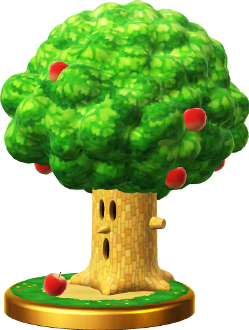
A recurring boss in the Kirby series, usually the first one Kirby faces, and in one continuity, the guardian of Dream Land's forests. Whispy appears in Dream Land in the original and on Green Greens in Melee. In both games, he serves as a stage hazard that pushes the fighters with gale force winds.
- Blow You Away: In both stages where he appears.
- The Bus Came Back: After suffering through the two tropes below, both of his stages come back for the launch release of Ultimate.
- Chuck Cunningham Syndrome: Absent from 3DS's base game. However, he returns in the Dream Land (64) stage DLC.
- Demoted to Extra: He's degraded to a mere trophy in Wii U, though as with the above, he reappears in the Dream Land (64) stage DLC.
- Edible Ammunition: On the Green Greens stage, he can drop apples which do damage when they fall. They also provide throwable items or food for recovering.
- When Trees Attack: As if the other tropes didn't already make that apparent.
Melee
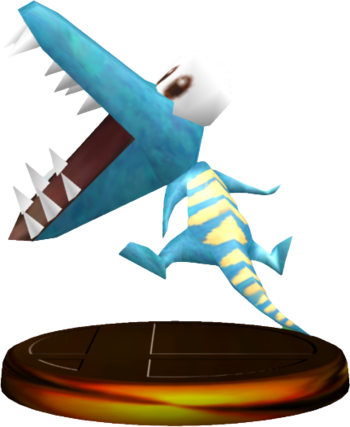
These crocodiles with large snapping jaws are part of the Kremling Krew, constantly chomping at everything in front of them. In the stages they appear in, they swim in the river, hoping to take a bite out of anyone.
- Ascended Extra: They become an Assist Trophy in Ultimate.
- Never Smile at a Crocodile: Crocodile-like monsters that lurk in the water, waiting to snap and bite at anyone who falls in.
The various machines that participate in the F-Zero races. They move at lightning speeds on Mute City (later Port City) where they act as hazards to the player. Smaller versions of the racer also show up in Big Blue where they act as mobile platforms that the fighers can temporarily take refuge on.
- Car Fu: Not intentionally, but they can easily plow through any fighters that make the mistake of standing in their way and they'll do so without slowing down in the slightest.

A high-ranking Space Pirate alongside the likes of Ridley, known for his immense size. Kraid appears in the Brinstar Depths stage as a background character, rotating the large stage with his claws. In Ultimate, he also appears as a Master Spirit who runs a dojo teaching the Tank Style.
- Art Evolution: His appearance in Melee, through impressive for the time, is a rather simple model by today's standards. The updated model
 ◊ in Ultimate has much greater detail, bringing it closer to his established appearance in Super Metroid and Metroid: Zero Mission. This is best exemplified by his face, where the shapes of his crests, horns, and eyes are much closer to his canonical design. His tail and arms are also given the ridges that are present in Super Metroid.
◊ in Ultimate has much greater detail, bringing it closer to his established appearance in Super Metroid and Metroid: Zero Mission. This is best exemplified by his face, where the shapes of his crests, horns, and eyes are much closer to his canonical design. His tail and arms are also given the ridges that are present in Super Metroid. - Background Boss: One could argue that Kraid is the original stage boss. However, since he's in the background and can't be hit, he doesn't count as a proper boss, hence his placement here. He hops out of the lava of his stage, swipes at the large platform, and causes it to rotate before sinking back in.
- The Bus Came Back: Kraid's only proper appearance in Smash Bros. used to be in Melee. He only appears in Brawl as a sticker, and doesn't appear at all in 3DS/Wii U. Ultimate, however, brings back Brinstar Depths and him along with it. Ultimate is also his first physical appearance in a game since Metroid: Zero Mission, released 14 years prior.
- Demoted to Extra: After appearing in Melee as a stage hazard and trophy, Kraid's only appearance in Brawl is a sticker.
- Even the Subtitler Is Stumped: Kraid's "dialogue" in Ultimate is fortunately translated. However, whoever is providing the translation isn't very sure about it, often guessing what he means and ending sentences with question marks.Kraid: Gaaaaahhh!
(That's a... happy noise?) - Informed Attribute: His Melee trophy says that he "immobilizes enemies with his three red eyes." This was never an ability he had in Metroid, and it's not an ability he has in Smash either.
- Kaiju: In Super Metroid, Kraid takes approximately two vertical screens in his boss fight. You can definitely see how in his stage.
- Mighty Glacier: In his Spirit Battle, Kraid uses a giant King K. Rool puppet fighter that, while powerful, is handicapped by slow movement and decreased jump strength. His Tank Style even teaches other spirits to become Mighty Glaciers, by boosting offense and defense at the expense of movement speed and jump strength.
- Red Eyes, Take Warning: A trait from his home series. Downplayed in Meleenote , but emphasized in Ultimate.
- The Unintelligible: As a Master Spirit, Kraid speaks for the first time in a video game... and it's all roars and grunts with a translator on hand.
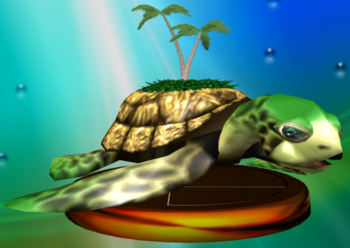
A giant turtle that resides in Great Bay, summoned by the New Wave Bossa Nova to take Link to the Great Bay Temple. It acts as a temporary platform on the stage.
- The Bus Came Back: Since the Great Bay stage returns in Ultimate, so too does the turtle.
- Turtle Island: It's scaled down compared to its home game, but it's undoubtedly this.

The choice ship of Star Wolf. They function exactly like the Arwings.
- Energy Weapon: Their main means of attack is firing powerful laser beams.
- Helpful Mook: They can be used as platforms, though you have to be careful about not having it fly off the stage with you on it.
- Space Fighter: Small, agile one-man spaceships that zoom around in space-themed stages and shoot lasers everywhere.
Brawl
A large member of the Grub-Dog family and one of the most iconic enemies from the Pikmin series. A large Bulborb occasionally appears on the right side of the Distant Planet stage, serving as a temporary platform for those brave or foolish enough to trust it not to eat them in the process.
- Attack of the 50-Foot Whatever: This particular Bulborb is abnormally large for its species to begin with, and given the scale of the fighters on the Distant Planet stage, the players can't even see its whole body in a normal match.
- One-Hit Kill: When the Bulborb opens its mouth, any fighter who gets close enough to it will get eaten and taken off the stage as the Bulborb retreats to enjoy its meal.

The Lunar Pokémon, known to provide pleasant dreams in contrast to the Pitch-Black Pokémon, Darkrai. Cresselia appears in the background of Spear Pillar, attacking everything with Psycho Cut. Easily the most dangerous of the three Legendaries to appear on this stage.
- Adaptational Villainy: In its home series, Cresselia is one of the more benevolent legendaries, using its powers to help cure chronic nightmares. Here, it’s the most dangerous of the three legendary Pokémon that can appear, wildly attacking with Psycho Cut.
- Calling Your Attacks: Cresselia's siren-like cry is the only warning that it's going to attack.
- Chuck Cunningham Syndrome: Unlike Dialga, Cresselia didn't show in any capacity in 3DS/Wii U, not even as a trophy. It returns to its role in Ultimate.
- Color-Coded for Your Convenience: In Brawl, the stage will be blue if Cresselia appears, though it usually means Dialga will appear instead.
- Light Is Not Good: Despite being the personification of the full moon and sweet dreams, it’s incredibly dangerous and malevolent in Smash.
- Mind over Matter: Due to being a Psychic-type, it won't directly attack. Instead, it will send Psycho Cuts everywhere it can reach.
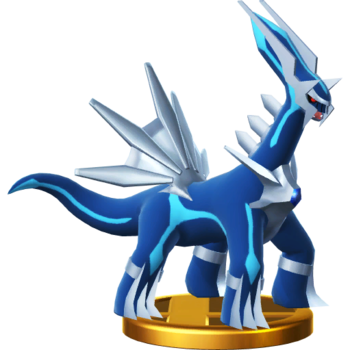
The Temporal Pokémon, said to control the flow of time itself. Dialga appears in the background of Spear Pillar, tripping up players with its time powers.
- Collision Damage: At times, Dialga will jump off its perch and onto the stage, damaging those unfortunate enough to be where it will land.
- Color-Coded for Your Convenience: In Brawl, the stage will be blue if Dialga is due to appear, though Cresselia might appear instead.
- Demoted to Extra: Compared to Palkia, Dialga doesn't even show up in 3DS and is only a trophy in Wii U. It reprises its role in Ultimate.
- Energy Weapon: At times, it will use what may be either Hyper Beam or Flash Cannon, sending a beam of light across the stage. Obviously bad news for players.
- Olympus Mons: The representation of time itself, and one of the deities involved in the creation of the Pokémon universe.
- Time Master: Roar of Time will slow down the entire battle. It will also distort the screen's image to the point of Interface Screw.

The fish from Balloon Fight, who would see anyone who gets near its waters as a tasty snack. It appears on the Summit stage and the Balloon Fight stage.
- One-Hit Kill: Anyone who gets eaten by the fish on the Summit will be dragged off the stage.
- Retraux: On the Balloon Fight stage, it appears in its sprite form.

The leader of the Bulblins, desert-dwelling bandits employed by Ganondorf to assist in his conquest. Throughout the events of Twilight Princess, he led the raid on Link's home of Ordon Village and kidnapped its children. He and Link would occasionally trade blows, sometimes on horse/boarback and sometimes on foot. After his final defeat at the hands of Link, he stepped down and gave Link his Small Key. On the Bridge of Eldin stage, he'll occasionally ride by on Lord Bulbo and blow up the center for a brief time.
- Horse of a Different Color: He rides a giant horned boar named Lord Bullbo.
- I Fight for the Strongest Side!: His Brawl trophy references his saying this after Link beats in their last battle last scene in Twilight Princess.
- King Mook: Of the Bulblins. A regular Bulblin will occasionally follow him on stage.
- Somebody Set Up Us the Bomb: King Bulblin will ride onto the stage and drop a bomb, which will go off a few seconds later. The section of bridge that gets blown up will return soon after.

Trouble Bugs, sometimes just called Fireballs, have the honor of being the very first enemies ever featured in the Mario and Donkey Kong games, having been the only "common" foes in the original arcade game both series come from. In Smash Bros., these living balls of fire hop out of burning oil bins in the 75m stage, moving along the platforms and harming any fighter they touch.
- Evil Living Flames: They're living masses of fire with simple dot eyes, and only exist to drift into fighters and burn them.
- Retraux: Like the rest of their stage, they're rendered in the pixellated, 8-bit graphics of their original arcade game.

An invincible monstrosity created in one of the Pig King's chimera labs, the Ultimate Chimera is insanely powerful and nigh-unstoppable; even the lab that created the beast was unable to keep it contained. It appears in New Pork City as a stage hazard which will instantly KO whatever unlucky fighter gets close to it.
- Attack Its Weak Point: Subverted. Attempting to jump on the shutoff button on the chimera's back will do nothing other than get yourself bit.
- The Bus Came Back: Thanks to New Pork City returning as a stage in Ultimate, the Ultimate Chimera returns along with it.
- Mythology Gag: In MOTHER 3, touching it instantly causes a Non-Standard Game Over without even initiating a battle. Ultimate echoes this by having it cause a Non-Standard Knock-out upon touch: the victim is destroyed on the spot, rather than being sent flying off-screen like in Brawl.
- Not So Invincible After All: While impossible to beat in a straight up battle, breaking the wooden platform on the bottom of the stage while the Ultimate Chimera is on it will get rid of it sooner than letting it despawn will.
- One-Hit Kill: Its bite deals 200% damage and enough knockback to be KO'ed from across New Pork City. Incidentally, it is survivable if the player ends up bouncing between the parallel walls on both ends of the stage. Not so much anymore in Ultimate, where the Ultimate Chimera will simply obliterate anyone unfortunate to be caught by its jaws.
3DS/Wii U
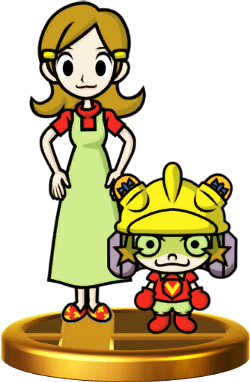
9-Volt's mom. She's a gamer like her son, but she's much more reasonable than he is, and makes sure he isn't sacrificing sleeping time for gaming time. In Smash, she can pop up from time to time in the Gamer stage. If she does, you'd better hide, because she will get mad and blow away any fighter she sees.
- The Artifact: As a hazard, she is not shown wearing her yellow apron from Gold, despite spirits and the stickers on Gamer using artwork from it.
- Berserk Button: Seeing 9-Volt or any of the Smashers playing during bedtime.
- Glowing Eyes of Doom: Her eyes glow yellow when she appears on stage, shining searchlight-like beams and dealing considerable damage to any fighters caught in her gaze.
- Nightmare Face: She's normally a mild-mannered mom who's good at video games, but if she spots you playing Smash after bedtime, she'll roar like a lion, inexplicably grow fangs and horns, and launch you off the stage.
- Red Eyes, Take Warning: Her eyes turn red when she gets mad.

The result of the combined efforts of dungeon master Brick Road and scientist Dr. Andonuts, Dungeon Man is the world's first fusion of man and dungeon. In Smash, he'll occasionally appear in Magicant, walking along the bottom of the stage and serving as a platform.
- Art Evolution: In Ultimate, he's redesigned to look more like his original concept art.
- Easter Egg: You can see Brick Road's face if you peer through Dungeon Man's eyes while the game is paused.
- Gentle Giant: Despite his size, he's a pretty nice guy.

A uniquely behaving character in Magicant, these bird-men represent the courage of those who dream up their realms. There are five in total, and once they're all defeated, they're gone for good. On the Magicant stage, the first player to make contact with the Flying Man recruits him as an ally, upon which he will start to attack that player's opponents. He can be hit and knocked away like a player character and is designated as a CPU.
- Assist Character: Unique in that he's a stage-based one, and an elaborate one at that.
- Bird People: They're muscular, bird-headed men who occasionally make squawking noises.
- Instant Gravestone: Once a Flying Man dies, a gravestone will pop out on the side of the building it came out of.
- Permadeath: Like in EarthBound and EarthBound Beginnings, if a Flying Man is KO'd, he stays dead. There are only five Flying Men, so after the fifth one dies, no more Flying Men will come out.
- Sprite/Polygon Mix: Manifests as a sprite.

A high-ranking Magikoopa who serves Bowser. He flies around the Mushroom Kingdom U stage changing the layout with his magic.
- Flying Broomstick: How he gets around.
- Reality Warper: He uses his magic to change the stage's setting to a different layout.
- Robe and Wizard Hat: Wears these.

Collectively known as Twinrova, these two witches and surrogate mothers to Ganondorf fly around the Gerudo Valley stage wreaking havoc with their Elemental Powers.
- An Ice Person: Kotake specializes in ice magic, and can freeze part of the stage.
- Flying Broomstick: They fly around on these when they appear in Gerudo Valley.
- Platonic Co-Parenting: They're Ganondorf's adoptive parents, although they're sisters.
- Playing with Fire: Koume's specializes in fire magic, and can spread flames for the players to avoid.
- Red Oni, Blue Oni: To each other; naturally, the ice user is blue and the fire user is red.
- Wicked Witch: The closest thing the Zelda series has to the classic witch archetype. Hook noses, old age, et al. Their combined form, Twinrova, is substantially more attractive, but doesn't make an appearance in the game proper, only as a trophy in 3DS and as a spirit in Ultimate when enhanced.


Originally normal trains, they became possessed and started attempting to ram into Link on his quest. At certain points, the much more persistent Armored Trains would appear, much less vulnerable and far more intelligent. They appear on occasion as platforms on the Spirit Train stage, but will also land on the train and blow up.
- Action Bomb: They'll sometimes flop onto the train and blow up shortly after, causing a lot of damage to anyone in its wake.
- Cool Train: They're demonic trains. The armored variant does look pretty cool.
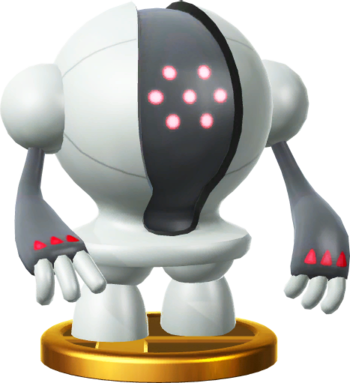
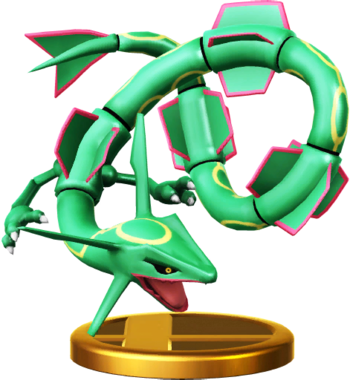
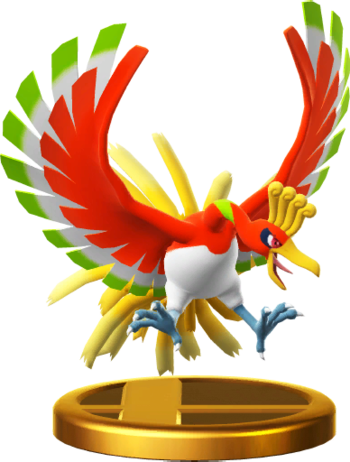
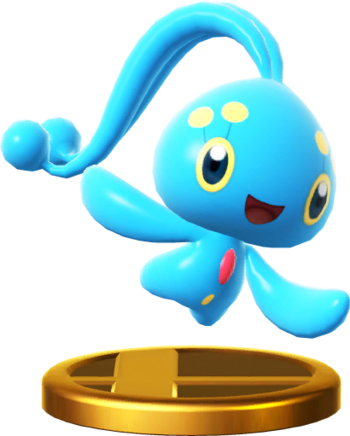
Pokémon Ruby and Sapphire [GBA], 2002 (Registeel, Rayquaza)
Pokémon Diamond and Pearl [DS], 2006 (Manaphy)
Four legendary Pokémon who sometimes appear in each chamber of the Kalos Pokémon League. Ho-Oh and Manahpy were previously Poké Ball summons, while Rayquaza was a boss. See their respective pages for more info.
The fourth, Registeel, is the Iron Pokémon and a member of the Regi Trio whose mysterious body is harder than any known metal.
- BFS: Though it doesn't pick them up, Registeel's earthquake attack causes the gigantic sword platforms in its chamber to uproot and swing around.
- Giant Flyer: Rayquaza is long enough to stretch across the entirety of the screen without fitting completely, and interacts with the stage by flying around above it and damaging fighters who run into it.
- Making a Splash: Manaphy transforms the main platform into a hollow funnel shape and uses Whirlpool to draw any fighters to the opening at the center.
- Olympus Mons: Four extremely powerful, unique creatures from a Mons game.
- Playing with Fire: Ho-Oh's Sacred Fire attack creates gigantic pillars of fire either just off of the platforms or underneath the two smaller platforms launching them high into the air.

A huge fairy who Pac-Man returns a lost fairy to in Pac-Land. In Super Smash Bros. she awards the winged boots to the first players who can grab them, greatly boosting their jump height.
- Our Fairies Are Different: She resembles a human woman with insect wings, wearing a long pink robe.
- Retraux: She appears in pixelated form, like the rest of her stage, to reflect the graphics of her original game.
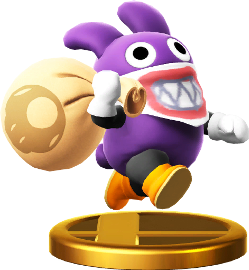
A rabbit-like thief from the Mushroom Kingdom who is known for stealing items from Toads, though he has helped out Luigi at least once. In Smash, he appears in the Mushroom Kingdom U stage, trying to kidnap the fighters.
- Bag of Kidnapping: He tries to capture the fighters by stuffing them inside his bag.
- Flight: He's given the ability to fly straight up like a rocket, which he does not possess in his original games.
- One-Hit KO: If Nabbit successfully makes off with you, you'll be carried directly off the stage and KO'd. Wiggling and button mashing can help you escape, but the more damage you've taken, the less likely you are to break out.
- Rascally Rabbit: He has rabbit ears, and while he is not shown being evil per se, he is still a thief and, in this game, a kidnapper.
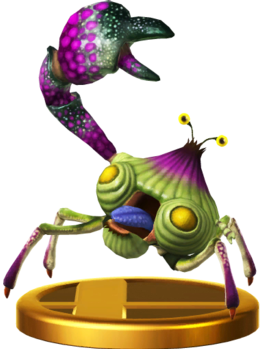
A giant grab-like creature that lurks near water and grabs Pikmin with its powerful pincers. On the Garden of Hope stage, it simply rams into opponents from either side of the stage.
- Giant Enemy Crab: While in its home franchise it's no larger than any real-life crab and only appears colossal to the insect-sized protagonists, in Smash it's much larger than the human fighters.
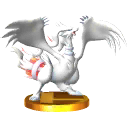
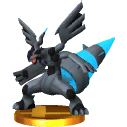
The two mascot legendary Pokémon of Pokémon Black and White, the Vast White and Deep Black Pokémon, said to respectively represent truth and ideals and each being one third (the other is Kyurem) of the Legendary dragon Pokémon that saved the Unova region in times past. Reshiram and Zekrom appear in the background of the Unova Pokémon League stage.
- Our Dragons Are Different: Both of them are primarily Dragon-types, though Reshiram is Dragon/Fire and Zekrom is Dragon/Electric.
- Lightning/Fire Juxtaposition: Reshiram's secondary typing is Fire contrasting with Zekrom's Electric typing.
- Playing with Fire: Reshiram will use Fusion Flare set the stage platforms on fire, localized to either the sides or the center.
- Shock and Awe: Zekrom will use Fusion Bolt to hit the stage, either hitting fighters in the center, or destroying stairways and tilting it if it hits the sides.

A shark that lurks in the waters on the edges of Tortimer Island, and which will attack any fighters who swim too far out.
- Adaptational Villainy: In the original games, sharks were docile and would not attack even if you swam by them, instead swimming away. Here, they actively attack swimming fighters.
- Border Patrol: It lurks in the water on the edges of its stage, and will emerge to attack any players that stray too far from the island itself. It won't appear if hazards are turned off.
- Threatening Shark: A large, aggressive shark that will attack anyone who approaches it or enters the water."The shallow waters around the island are home to some vicious sharks. They'll swim close and try to make a meal of an unsuspecting fighter."
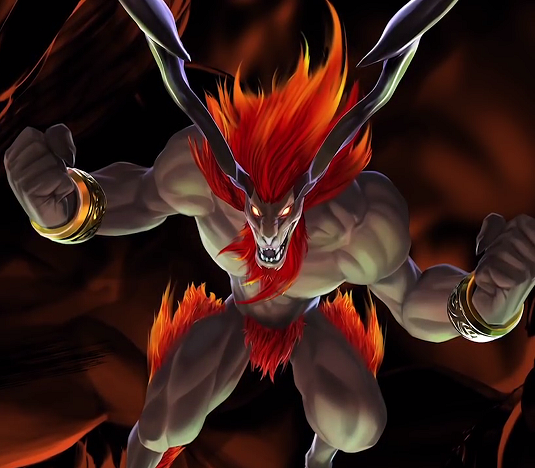
Summoned creatures, also known as "Eidolons" of "Espers" in a variety of titles, whose powers are often called upon by various heroes across the franchise to bring devastation upon their foes. Cloud Strife and his party called upon their strengths throughout their journey across the Planet with Summon Materia. In Smash, they appear on the Midgar stage, wreaking havoc upon fighters with their almighty power. The summons appearing are as follows:
- Ifrit: Lord of the Inferno, who casts Hellfire to push the stage around, as well as torch any victims unfortunate enough to be struck by his flames.
- Ramuh: The Lord of Levin, whose Judgment Bolt shifts the top platforms of the stage about, as well as electrically charging them to stun and harm his foes.
- Odin: The Dark Divinity, riding into battle on his mighty steed to cleave the stage (and possibly One-Hit KO hapless fighters) with his mythic blade, Zantetsuken.
- Leviathan: The Lord of the Whorl, whose Tidal Wave will wash away any enemy unfortunate enough to fall into the mighty floods he summons.
- Bahamut ZERO: The Dreadwyrm, whose devastating Mega Flare will engulf half of the stage and destroy anyone in the blast zone.
- Absurdly Sharp Blade: Odin's sword can cleanly slice the stage in half with a well-placed Zantetsuken.
- Assist Character: The player summoner is immune to the attacks (but not the currents of Tsunami), with the exception of the Zantetsuken.
- Battle Aura: Whoever summons them is enveloped in a red aura during their attack.
- Interface Screw: Tera Flare causes a ton of screen shaking when it hits, which is likely to disrupt everyone that isn't the CPU.
- Making a Splash: Leviathan, a sea serpent with dominion over water, which uses his Tidal Wave attack to flood the stage. In Smash, he completes the elemental trifecta with Ifrit and Ramuh, taking a place usually reserved for Shiva in the main series.
- Mythology Gag: While their origins date back to the earliest of Final Fantasy titles, the Summons appear in their Final Fantasy VII incarnations (except for Ifrit, who has an updated appearance more similar to his feline incarnations).
- Playing with Fire: Ifrit, a fire demon infamous for its destructive Hellfire ability. In Smash, it attacks by creating pillars of fire and, alongside Leviathan and Ramuh, completes the major elemental trifecta.
- Shock and Awe: Ramuh, a god of thunder who appears atop a cliff to conjure the Judgement Bolt and electrify parts of the stage. In Smash, he completes the major elemental trifecta alongside Ifrit and Leviathan.
- Signature Move: The Summons each have one move they're most famous for.
- Ifrit: Performs Hellfire. Ifrit attacks the stage with powerful flames, forcing the stage to tilt and incinerating fighters close to the blast point.
- Ramuh: Performs Judgement Bolt. Lightning strikes the stage's three floating platforms, causing their locations to shift and enveloping one in electricity. Fighters who come in contact with the rigged platform will take electric damage.
- Leviathan: Performs Tidal Wave. Floods the vicinity with a raging storm. Fighters who fall off the left side of the stage are liable to be swept away by the powerful current. Fighters who fall off the right side will collide with the stage and take damage; if their damage is at least 100%, they will be instantly KO'd instead.
- Odin: Performs Zantetsuken. Odin delivers a cleaving vertical strike down the center of the stage. Any fighters caught in the blow are launched skyward to their untimely deaths. Immediately afterwards, the stage splits cleanly in two. Eventually, it melds back together, crushing anyone stuck between the halves.
- Bahamut ZERO: Performs Tera Flare. Bahamut unleashes a powerful laser beam from its mouth at the ground in the distance, then quickly approaches the foreground. Any fighters unfortunate enough to be caught in the beam are subsequently disintegrated.
- Single-Stroke Battle: Upon being summoned, Odin performs Zantetsuken to cut the battlefield in half. This will usually KO anybody that is in the middle of the stage. This carries over to the stage reformation, which can KO fighters sandwiched in the middle.
- Sprite/Polygon Mix: All of the summons are depicted as high-resolution 2D artwork, with Midgar itself being modeled in 3D.

The Goddess of Nature and a major character in Kid Icarus: Uprising. She despises humans for disrupting the balance of nature and has tried on some occasions to wipe them out, though she's been put in situations where she's had to assist Pit and Palutena instead. In the Reset Bomb Forest stage, she unleashes her reset bombs upon the warring humans in retaliation for the damage they've inflicted on nature. She also appears in most of the "Palutena's Guidance" secret taunts.
- Anti-Armor: Her spirit's effect in Ultimate is Metal Killer. Which deals extra damage to Metal enemies.
- Badass Adorable: She is the deity of all things nature-related, and has proven a formidable foe to Pit and the Underworld Army. All while looking (and to an extent, acting) like an adorable little girl.
- Deadpan Snarker: Viridi is an absolute master of sarcasm, and doesn't hold back with the snark during her conversations with Pit and Palutena.
- Does Not Like Spam: According to the Palutena's Guidance for King K. Rool, she not only doesn't like bananas, but also thinks only idiots eat them. This may be a reference to how Cavendish bananas (the type that Donkey Kong's bananas are based on) are the result of human cultivation, rather than a naturally-evolved plant.
- Dual Boss: Her Spirit battle has you fight a Mii wearing her outfit, representing her, and a black Kirby who spams Stone, who represents her rocky general Cragalanche.
- Fantastic Nuke: At her beck and call are Reset Bombs, superweapons that not only create massive explosions, but leave behind a large tangled mass of brambles that eventually becomes fertilizer for dense and impenetrable forests. The Reset Bomb Forest stage from 3DS and Ultimate demonstrate the bomb's destructive power.
- Fantastic Recruitment Drive: She's seemingly gearing up for another war on humanity and looking for new troops — having already recruited Dark Pit — and wants to recruit Lucario due to its immense life-force.
- A Form You Are Comfortable With: It's strongly implied in the Palutena's Guidance for Bayonetta that her true form is very different from what we see.
- Friendly Enemy: She declared war on humanity — who Palutena and Pit are sworn to protect — in the past, and judging by her commentary in Dark Pit's and Lucario's Guidance conversations, intends to do so again. Despite this, she has a fairly amicable relationship with Palutena and Pit and regularly converses with them. And as listed under Tsundere below, she's hinted to have a thing for Pit in spite of all the shade she throws his way.
- Gaia's Vengeance: The Reset Bomb Forest stage depicts the scene where she stops a war between human nations by dropping a divine fruit that explosively grows into a forest, designed to attack humans and everything they build. Her Spirit's effect is Metal Killer, which also shows off her hatred of anything non-natural, like refined metals.
- Green Thumb: As expected from the goddess of nature. She's one of the spirits who can make the giant beanstalk grow in World of Light.
- Hypocritical Humor:
- During the Palutena's Guidance conversation for Robin in Wii U, Viridi taunts Chrom for not making it to Smash Bros. because he and Ike are too similar and having carbon copy fighters would be pointless. Dark Pit, one of the representatives from her series and newest member of the Forces of Nature, is a literal clone and a Moveset Clone of Pit. Ditto for Chrom's own daughter being a clone of Marth.
- A DLC-exclusive example: during the Palutena's Guidance on the Mii Swordfighter, she comments that the Mii is "awfully funny looking". Guess which fighter class gets the Viridi costume? That's right; you get to make her call a Mii version of herself "funny looking".
- She's quick to swoon over the more handsome men in the cast, despite her hatred for humanity.
- Irony:
- Not only can the Mii Swordfighter she makes fun of wear an outfit made in her resemblance, but when found as a spirit in Ultimate, she's possessing the Mii Swordfighter itself using said outfit.
- She's ecstatic over the Inklings in their world to have taken over after humanity was killed off...except that the Inklings are pretty much still the same and fight on a regular basis.
- The Knights Who Say "Squee!": She has quite the crush on Link, and thinks Marth is quite handsome as well… for a hairless monkey. She also joins the others in gushing over Mega Man. In Ultimate, she gushes over Roy and the Piranha Plant, too.
- Leaning on the Fourth Wall: Like the other Kid Icarus characters, Viridi displays a degree of Medium Awareness.Motion control... that's revolutionary! We should patent that.
- Motor Mouth: The entirety of the Palutena's Guidance on the Piranha Plant consists of her rapidly listing off all the variations of the enemy, which goes on for quite some time.
- Nature Spirit: Or Nature Goddess, more properly. This enables her to sense the life-force of others.
- Pop-Cultured Badass: She's the goddess of nature and an expert on all things Nintendo.
- Really 700 Years Old: Like all angels and goddesses. She's thousands of years old, but she's physically and mentally a little girl of around 8 years old. Lampshaded by Pit in the Palutena's Guidance about Ike in Wii U.
- Son of an Ape: She refers to humans as "monkeys" to show her disdain for them.
- Super-Empowering: She grants Dark Pit the Power of Flight and also helps Pit out when Palutena's in the arena.
- This Is Unforgivable!: Mewtwo's existence makes her furious. She screams at the humans who created it in a rage for tampering with life without considering the damage a genetically-engineered creature like Mewtwo might have on the ecosystem.
- Tsundere: Just like in Uprising, Viridi loves to tease or insult Pit, but she'll still give him advice and cheer him on.
Ultimate
Stage Cameos
Brawl
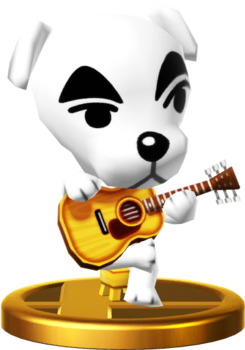
A traveling musician from the Animal Crossing series whose songs can be heard once a week. In Super Smash Bros., he'll appear on the Smashville and Town & City stages every Saturday from 8 to 12 PM and play some of his songs during the battle.
- Early-Bird Cameo: He appears in Melee as a trophy.
- Funny Animal: K.K. is a talking dog, in tandem with Animal Crossing as a whole.
- Wandering Minstrel: Always shows up on the Animal Crossing stages once a week.
Three Legendary Pokémon said to live hidden deep within the great lakes of the Sinnoh region, each governing an aspect of the human spirit: Uxie of Lake Acuity, with power over knowledge; Mesprit of Lake Verity, with power over emotion; and Azelf of Lake Valor, with power over will. In Smash, they will occasionally appear in the background of the Spear Pillar stage.
- The Cameo: Essentially what their appearance serves as, since they don't affect the battle at all.
- Olympus Mons: Three Legendary Pokémon of the Sinnoh region, and incredibly powerful despite their diminutive appearance.
- Power Floats: All three of them have the Levitate ability and are pretty much never seen with their feet on the ground.
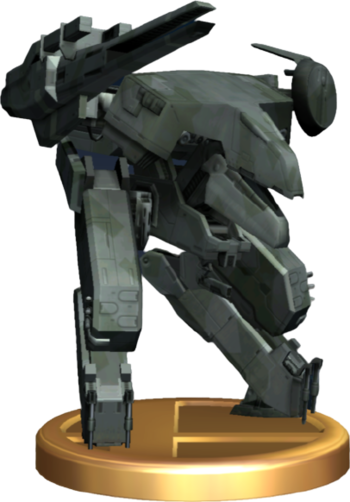
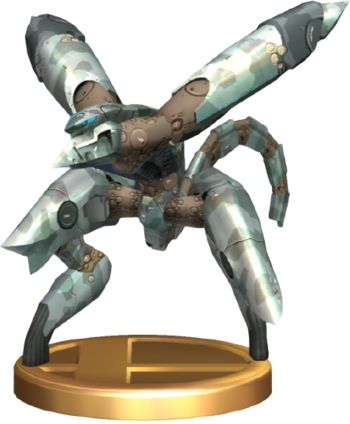
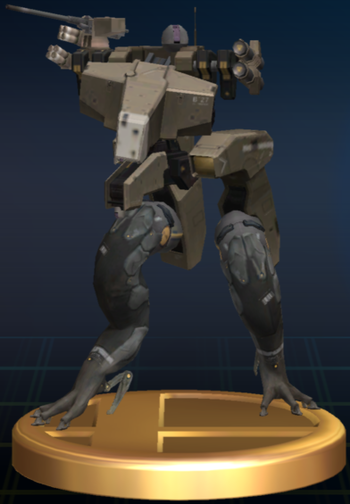
The titular Metal Gear is a series of nuclear-armed bipedal tanks. The REX model was designed for the U.S. Army on Shadow Moses Island, while the RAY version was created for the Marine Corps to combat REX copies made by third-parties after REX's schematics were leaked online. They sometimes crash into the back wall on Shadow Moses Island and wreak havoc in the background. The Gekkos, autonomous fighting vehicles designed by the AT Corp, also appear in this fashion.
- Adaptational Intelligence: Normally, Metal Gear REX requires the pilot to sit in its "mouth". Here, there's no pilot present, appearing as if REX is acting on its own.
- Dumb Muscle: On paper, the Gekko are sentient machines that can cause serious damage when provoked. Most of the time, they're really clumsy.
- Early-Bird Cameo: The Gekkos made their first appearance in a video game in Brawl before their official debut in Metal Gear Solid 4 later that year.
- Humongous Mecha: The Metal Gear are designed to be walking nuclear warheads.
- Meaningful Background Event: The Shadow Moses Island stage, both versions of Metal Gear appearing, and the existence of the Gekkos serve as foreshadowing for the Metal Gear battle between Snake and Liquid Ocelot in Metal Gear Solid 4.
- Meat-Sack Robot: Those legs of the Gekkos are actually pretty-much cloned cow legs.
- Mini-Mecha: Gekkos are much smaller than the REX and RAY models.

A bizarre relative of the Pikmin, Onions are essentialy living ships that act as the Pikmin's hive, housing them and flying into the atmosphere to protect them from PNF-404's dangers, and helping the species reproduce when fed organic matter. They appear in the "Distant Planet" stage, landing in random spots for a while before flying off. Feeding them pellets will reward you with an item, with the corresponding color pellet or higher value ones earning higher value items.
- Art Evolution: Averted. Pikmin 3 redesigned them to give them a more berry-shaped, bio-mechanical look. While Smash has updated Olimar's design to be close to his appearance in 3, the Onions have retained their design from the first two games.
- Color-Coded for Your Convenience: Red, Yellow and Blue, the three original Pikmin colors. Feeding them the appropriate color pellet nets you better rewards.
- Living Ship: It's an organic spaceship for the Pikmin. Their debut appearance has them found planted in the ground, their petals can spin to help them achieve flight, and they're sentient enough to follow captain's without any further prompting. Whatever it is that they are, they are definitely alive.
- Video Gamecruelty Potential: Player's can attack the ship in order to make it leave sooner. A good strategy if you want to deny your opponent a chance for good items.

A giant parasite used for the Space Pirates' Phazon experiments, this giant bug serves as the first boss of Metroid Prime. It appears in the Frigate Orpheon's background.
- The Bus Came Back: Thanks to Frigate Orpheon returning as a stage for Ultimate, the Parasite Queen returns along with it.
- Monstrous Scenery: Her huge form dominates the background of the stage, but she doesn't interact with the fighters in any way.
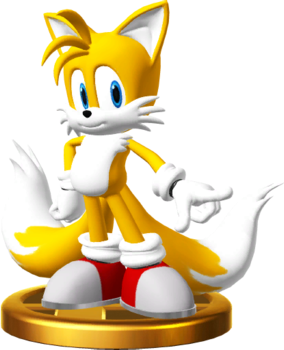
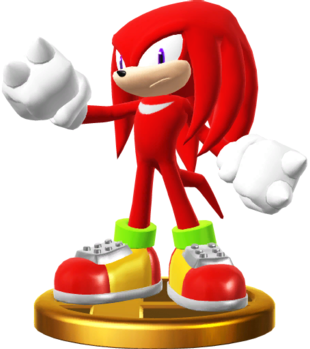

Three of Sonic's friends from across his adventures. Miles "Tails" Prower is Sonic's sidekick and an exceptionally skilled mechanic who can fly with his two tails, Knuckles the Echidna is the gullible yet well-meaning guardian of the Master Emerald, and Silver the Hedgehog is a psychic from a Bad Future where the villains succeed in their goals. They all appear in the background of Green Hill Zone.
Knuckles himself has been made into an Assist Trophy in Ultimate. For more information on that, see here.
- Ascended Extra: Knuckles is made into an Assist Trophy for Ultimate. As he still appears in the background of Green Hill Zone, he can't be summoned on that stage.
- Flight: All of them are capable of this. Tails can use his namesake like a propeller, Knuckles glides with his dreadlocks, and Silver can levitate with his psychic powers.
- Kid Hero: Respectively, Tails is 8, Knuckles is 16, and Silver is 14.
- Power Floats: Silver, as seen when he runs/levitates past Green Hill Zone. Funnily enough, he even does this when going through the giant loop in the middle, which ends up defying all laws of physics and makes his inability to do so in his debut's multiplayer a little awkward in hindsight.
- Psychic Powers: Silver is a powerful user of Psychokinesis, and puts it to good use.
3DS/Wii U
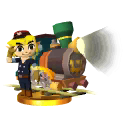

The Link of Spirit Tracks is an aspiring engineer who is thrust into the life of a hero when evil forces separate Princess Zelda's spirit from her body in an attempt to awaken the Demon King, Malladus. He appears on the Spirit Train stage to drive it, but if at least one variant of Link is present among the fighters, he'll be replaced by his mentor, Alfonzo, instead.
- Composite Character: Implied, since Toon Link appearing means he isn't on the stage. However, the playable Toon Link is the star of Wind Waker and Phantom Hourglass, while this Link, the one from Spirit Tracks, is a different character who lived a few generations after him. The conductor Link also disappears when adult Link or Young Link are on the stage as well, despite again not being the same person as themnote .
- Developer's Foresight: Alfonzo appears when any form of Link is fighting on the Spirit Train stage.
- The Mentor: Alfonzo was once the greatest swordsman in Hyrule before settling down in Aboda Village to become an engineer. He serves as Link's mentor before Spirit Tracks' conflict stirs up.
These Pokémon appear in the background of the Elite Four chambers on the Kalos Pokémon League stage, being released from Poké Balls to watch the fight. Occasionally, a Legendary Pokémon will appear instead to wreak havoc (see their own folder above).
The following Pokémon appear in each chamber:
- Dragonmark Chamber: Dragonite, Garchomp, Axew, Hydreigon
- Blazing Chamber: Blaziken, Infernape, Tepig, Pyroar (Male)
- Ironworks Chamber: Steelix, Scizor, Klinklang, Honedge
- Flood Chamber: Blastoise, Wailord, Piplup, Clawitzer
With the introduction of Mii Fighters, characters who are otherwise not part of the main roster can be represented. Every single costume introduced in this game has made it into Ultimate, with all of the third-party costumes once again being DLC. Characters introduced into the series by way of Mii Fighter outfits are as follows:
- X (Gunner): The protagonist of the Mega Man X series. Hailing from the distant future, X is a Maverick Hunter who fights to defend the fragile peace between humanity and the machine race known as Reploids. Also appears in Mega Man's Final Smash.
- Zero (Swordfighter): The deutertagonist of the Mega Man X series. Although he was originally created by the evil Dr. Wily, he joins X in his fight to protect mankind from the threat of Mavericks. Would recieve an Assist Trophy in Ultimate.
- MegaMan.EXE (Gunner): The protagonist of the Mega Man Battle Network series. The NetNavi of Lan Hikari, MegaMan protects the world from the threat of cyberterrorism.
- Proto Man (Gunner): The first robot created by Dr. Light. While he also shares Mega Man's sense of justice, he is a highly independent robot who prefers to do things his own way.
- Dunban (Swordfighter): A party member from Xenoblade Chronicles 1. A veteran of the war with Mechonis, he joined Shulk in his fight against the Mechon threat.
- Isabelle (Gunner): The dutiful assistant to the mayor from Animal Crossing. Promoted to Playable as of Ultimate.
- Heihachi Mishima (Brawler): A key character from the Tekken series. As the head honcho of the Mishima Zaibatsu, Heihachi is determined to prove himself the mightiest man alive. Would later appear in Ultimate as an 8-Bit sprite in one of PAC-MAN's taunts and as a background character.
- Akira Yuki (Brawler): The protagonist of Virtua Fighter. A practitioner of Bajiquan, he enters fighting tournaments to hone his skills. Also appears as an Assist Figure in Ultimate.
- Jacky Bryant (Brawler): Another character from Virtua Fighter. A race car driver by trade, he is also well-versed in Jeet Kun DO.
- Inkling (Gunner): The main characters of Splatoon. Rambunctious half-kids and half-squids who participate in Turf Wars. Promoted to Playable as of Ultimate.
- King K.Rool (Brawler): The antagonist of Donkey Kong Country. Leader of the Kremlings, he is determined to snuff out Donkey Kong and his crew. Promoted to Playable as of Ultimate.
- Flying Man (Brawler): Side characters from EarthBound. Inhabitants of Magicant, they are highly agile fighters.
- Chrom (Swordfighter): One of the protagonists of Fire Emblem: Awakening. The Crown Prince of Yllise, and leader of the wandering warriors known as the Shepherds. Promoted to Playable as of Ultimate.
- Black Knight (Swordfighter): A recurring character in Fire Emblem: Path of Radiance. A mysterious warrior who frequently crosses swords with Ike. Also appears as an Assist Trophy in Ultimate.
- Lloyd Irving (Swordfighter): The protagonist of Tales of Symphonia. A simple country boy until a sudden attack by raiders thrusts him into the world on a quest of salvation.
- K.K. Slider (Gunner): A recurring character from Animal Crossing. A world-famous travelling dog musician.
- Toad (Brawler): Recurring characters from the Mario series. Denizens of the Mushroom Kingdom.
- Viridi (Swordfighter): A major character from Kid Icarus: Uprising. The Goddess of Nature, who holds humanity in disdain.
- Hunter (Swordfighter): Based on the Monster Hunter series. Hunters traverse the realm to slay monters that threaten their home, using parts of the quarries to fashion weapons and armor.
- Rathalos (Swordfighter): Hunter gear from Monster Hunter made from Rathalos, one of the most dangerous dragons in the series.
- Geno (Gunner): A character from Super Mario RPG. An animate puppet who joins Mario on his quest to save the world.
- Takamaru (Swordfighter): The protagonist of The Mysterious Murasame Castle. A samurai who is on a quest to defeat the villainous Murasame. Also appears as an Assist Trophy.
- Ashley (Swordfighter): A recurring character from WarioWare. A teenage witch in training. Also appears as an Assist Trophy.
- Gil (Swordfighter): The hero of The Tower of Druaga. A knight who set off for a demonic castle to save the maiden Ki.
- Miles "Tails" Prower (Gunner): A recurring character in Sonic the Hedgehog. Sonic's best friend, and a genius mechanic.
- Knuckles the Echidna (Brawler): A recurring character in Sonic the Hedgehog. Protector of Angel Island, and Sonic's occasional rival. Also appears as an Assist Trophy in Ultimate.
- Chocobo (Hat): The feathery, yellow bird-like Mascot of the Final Fantasy series.

Pac-Man's Distaff Counterpart who, in spite of the "Ms." title, eventually tied the knot and started a family with Pac-Man. She appears at the end of a cycle of the Pac-Land stage waving to the players as they return to her house.
- Distaff Counterpart: She's quite simply Pac-Man, but a woman.
- Out of Focus: Despite being one of the main characters in the Pac-Man series and having a new render readily available, she doesn't get a trophy in 3DS/Wii U or a Spirit in Ultimate.
- Tertiary Sexual Characteristics: She's basically Pac-Man with heels and a bow.
- Writing Around Trademarks: Possibly the case, as her name is currently in a legal mess. While she appears, she is never once mentioned by name.
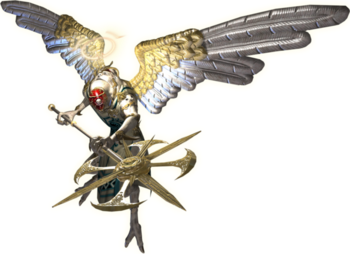
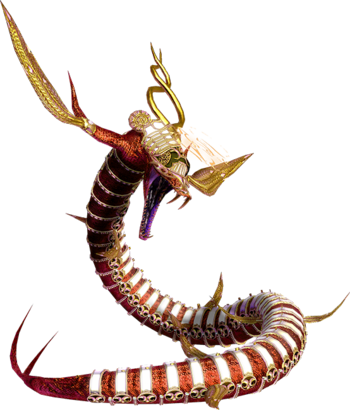
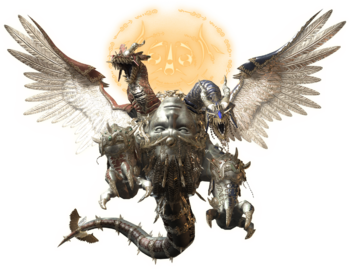
Angels who appear in Purgatorio, a dimension periodically visited by the Umbra Clock Tower during battles. They are Affinity, humanoid angels seen in great numbers; Inspired, serpentine beings who appear more rarely; and Fortitudo, a being resembling a winged, inverted human face with two draconic heads growing from its top.
- Angelic Abomination: Fortitudo is a powerful angel resembling a biomechanical two-headed dragon with bird wings and an upside-down human face for a body.
- Gold and White Are Divine: All three angel types make extensive use of gold and white in their palettes.
- Holy Halo: They all have halos in the form of intricate traceries of glowing golden lines floating over their heads.
- Interface Screw: Fortitudo's roar shakes the screen.
- Mighty Roar: Fortitudo flies up to the arena and roars at the combatants before flying away.
- Monstrous Scenery: They fly around in the background during the stage's Purgatorio cycle, briefly looming over the fighters before flying away, but never directly interact with the fighters.
- Our Angels Are Different: Monstrous, metal-plated, angelic beings found in another dimension, all winged but only one type actually humanoid — the others resemble a giant winged snake and a giant winged head topped by two draconic necks.
- Winged Humanoid: The Affinities resemble armored humans with metallic wings.
Occasionally appear in the background of the Unova Pokémon League stage instead of Reshiram or Zekrom. Unlike those two, however, these Pokémon are content to just watch the fight without interfering.
- Milotic: The Tender Pokémon, a Water-type from the Hoenn region renowned for its great beauty. It evolves from the deceptively weak and plain-looking Feebas.
- Shaymin: The Gratitude Pokémon, a Grass-type Mythical Pokémon from the Sinnoh region. It appears in Smash sporting its Sky Forme, which gives it a secondary Flying-type when it holds a Garcedia flower during the daytime.
- Whimsicott: The Windveilled Pokémon, a dual-typed Grass/Fairy Pokémon from the Unova region. A mischievous creature who rides the wind and pulls pranks using its soft, cotton-like hair.
Ultimate
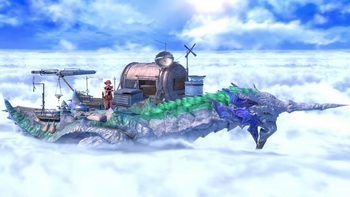
A huge flying creature known as a Titan, Azurda serves as Rex's home, transportation and mentor. He spends most of Xenoblade Chronicles 2 in a tiny larval state who stays inside Rex's helmet. In Ultimate, he appears in his larval state as part of the the Rex Mii costume, and he also serves as the main platform in the Cloud Sea of Alrest stage.
- Affectionate Nickname: Is usually just called Gramps throughout most of his home game, and by Rex in Pyra/Mythra's reveal trailer.
- Ascended Extra: Originally just a cosmetic of the Rex Mii costume, he now serves as the main part of a stage.
- Combat Commentator: He remarks on the battle taking place, including when someone loses a stock or when nobody has lost a stock in some time. He also has special comments reserved for Pyra and Mythra.
- Lampshade Hanging: "My back, a Smash stage? What will they think of next?"
- Late-Arrival Spoiler: Downplayed; only in the reveal trailer for the Rex Mii costume is it made clear that the small white creature in Rex's helmet and Azurda are one and the same.
Captain Toad is the leader of the Toad Brigade and an occasional treasure hunter. He sometimes appears in the New Donk City Hall stage on the roof of the building. If music from Captain Toad: Treasure Tracker is playing, he'll appear more frequently.
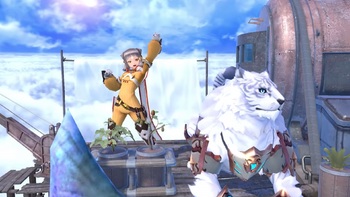
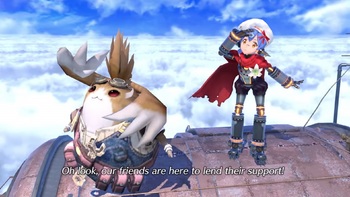


In the vast Cloud Sea of Alrest, some individuals, known as Drivers, are able to resonate with Core Crystals in order to summon and bond with a being called a Blade, who grants the Driver a weapon and supports them in battle with unique skills and powers. During Rex and Pyra's journey to find Elysium, they are accompanied by several Drivers and their signature Blade from across the various Titans of Alrest, each with their own reasons and ideologies for helping Rex find Elysium. They appear periodically on the back of Azurda, cheering on Pyra and Mythra from the sidelines.
- Nia and Dromarch: Nia is a sassy Gormotti Driver who initially joined the terrorist group Torna after having nowhere else to turn to. She was inspired by Rex's optimism in finding Elysium and decided to join his side after being disturbed by the cold, cruel tactics of Torna. Her signature Blade is the water-element Dromarch who grants Nia Twin Ring weapons. He is a well-spoken white-tiger who not only assists Nia in healing the party, but also allows her to ride on his back for comfort. Anything for his lady.
- Tora and Poppi: Tora is a Nopon engineer from Gormott who dreamed of becoming a Driver, but found himself unable to resonate with a Core Crystal (his nose bled for days after trying once). Luckily, with the research done by his Dadaponn and Grampypon, Tora was able to design and build his own Artificial Blade, Poppi, though his intentions for her may not necessarily have been for combat. She is (initially) of the earth-element and helps Tora fulfill a Stone Wall role with his Drill Shield. Having just been introduced into the world, Poppi approaches Alrest with much curiosity and child-like wonder, though she also lacks plenty of social awareness and often reveals some of Tora's more embarrassing secrets. Despite everything, Poppi loves her friends and Masterpon and will do what it takes to protect them.
- Mòrag and Brighid: Mòrag Ladair is the Special Inquisitor of the Empire of Mor Ardain (and cousin of its Emperor Niall), and one of the most renowned Drivers in all of Alrest. Initially an obstacle for Rex and co., she became an ally as both a representative of Mor Ardain and to see what the legendary Aegis Blade is capable of. She is strong-willed and dedicated to her country, and rarely loses her cool (unless one mistakes her for male). Her Blade is the graceful Jewel of Mor Ardain, Brighid. She's of the fire-element and grants Mòrag Dual Whip Swords. As to be expected of someone of her status, she is very polite and dutiful, though tends to be irritated at some of the shenanigans her party can get up to. Brighid fought alongside Mythra in a past form of herself and still has a rivalry with the Aegis despite not having any direct memories of it.
- Zeke and Pandoria: "Thunderbolt" Zeke von Genbu, Bringer of Chaos, is the bombastic Crown Prince of Tantal. He found himself in conflict with his country's outdated isolationist ways, thus was banished from his own home. He went on to become a special envoy of Indol, and was eventually tasked with tracking down and escorting Rex and the Aegis for an audience with Praetor Amalthus. Unfortunately, he has a bad habit of falling off cliffs. His Blade, Pandoria, is just as eccentric as he is, and has a poorly concealed crush on her Driver. She is of the electric-elemental and grants Zeke the Big Bang Edge.
- Bowdlerise: Similar to what happened with Pyra and Mythra, the sheer material on Brighid's outfit has been replaced by solid lilac-colored cloth.
- Robot Girl: Poppi, being an artificial Blade, looks more robotic than her Blade peers.
- Late-Arrival Spoiler: The presence of Mòrag and Zeke spoils the fact that these former adversaries become party members in Xenoblade Chronicles 2. The lack of a presence from Vandham and Roc spoils the fact that they aren't in the party for long...
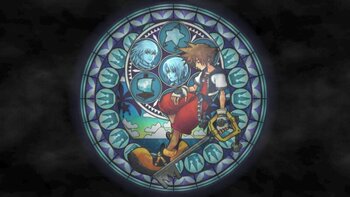
Once a fighter is knocked down to their final stock or time starts to run out, Hollow Bastion transforms into a mysterious realm known as Dive to the Heart. In the background, a variety of stained glass pillars featuring important Keyblade Wielders, and their associates, from across the series can appear.
- Sora (feat. Riku, Kairi, a raft, and a paopu fruit)
- Riku (feat. Ansem, Sora, and Namine)
- Roxas (feat. Axel, Xion, and Riku)
- Xion (feat. Axel, Saïx, Xemnas, and Sora)
- Terra (feat. Ventus, Aqua, and each of their Wayfinders)
- Ventus (feat. a Bunch of Wayfinders)
- Aqua (feat. Terra, Ventus, Vanitas, and Master Xehanort)
- Adapted Out: The original versions of Sora, Riku, Terra and Aqua’s Dives, which featured classic Disney toon characters and imagery, have either been replaced with their Memorial Stained Glass Clock designs or edited, both to omit the Disney toon cameos and imagery. This is likely due to Writing Around Trademarks.
- Donald Duck and Goofy, Sora's most consistent traveling companions, have their appearances on his Dive to the Heart replaced with the raft and paopu fruit from the first game, which directly represents Sora's start of The Hero's Journey. Riku is moved to where Goofy was.
- Riku's Dive to the Heart replaces Mickey with Sora.
- The Cameo: Putting aside the characters themselves, you can see images of Ansem, Namine, Saix, Xemnas, Vanitas, and Xehanort.
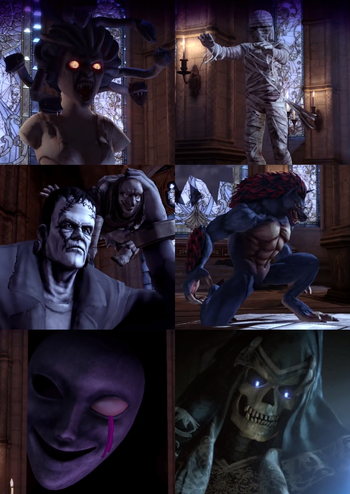
A variety of Gothic Horror monsters from the Castlevania series that appear from time to time in Dracula's Castle.
- Medusa: A hideous snake-haired woman's head initially disguised as a stone bust (not to be confused with the Medusa from Kid Icarus).
- Mummy: A pair of Egyptian mummies.
- The Creature & Flea Man: A Frankenstein's Monster and an Igor-like man on the former's shoulder.
- Werewolf: A muscular, acrobatic wolf-man.
- Carmilla: A vampire woman taking the form of a floating mask crying Tears of Blood (specifically purple Alien Blood).
- Death: Dracula's Dragon in the form of The Grim Reaper. His scythe is also a usable item.
- Kid Dracula: Dracula's son (whether or not its an alternate version of Alucard, or another child is left ambiguous) and the protagonist of the Lighter and Softer spin off series of the same name. Though he doesn't physically appear on the stage, his shadow will occasionally flash in the background when lightning strikes.
- Anthropomorphic Shift: Inverted with Carmilla. She was introduced as a crying mask in Simon's Quest and became a bleeding skull in Rondo of Blood before becoming a beautiful vampire woman in subsequent Castlevania appearances. Ultimate goes back to her crying mask look.
- Background Boss: Subverted. Several of them will approach the center of the stage and swipe at it as if to attack, but all they do is cause a candlestick to appear.
- Bandage Mummy: Humorously referenced in Dr. Mario's Classic Mode victory screen, where he and Peach in a white, nurse-like palette are standing in front of the mummy as if it were a bandaged patient.
- Dark Is Evil: Their color palettes predominantly consist of dark grays, blues, and purples, further emphasizing their gloomy and sinister designs.
- Dual Boss: Much like in the very first Castlevania, the mummies appear as a duo when they confront Luigi in the "Vampire Killer" trailer, though only one mummy at a time appears on the in-game stage itself.
- Dynamic Entry: Several of them enter the stage by crashing through the central window.
- Game Face: Medusa's face looks like a regular woman's when she first appears on the stage, but upon waking up she develops a monstrous face with snake-like Glowing Eyes and Scary Teeth.
- Half the Man He Used to Be: It's not clear if Death was ever a fully intact "man" as we understand it, but either way his skeleton is missing everything from the waist down.
- Hero Killer: Subverted; Death is introduced ripping Luigi's soul from his body, but Nintendo UK's Twitter account confirmed Luigi turned out OK; and indeed, at the end of the trailer, his soul was just about to reenter his body before being spooked one last time.
- Mistaken for Granite: Much like in her debut game, Medusa starts off looking like a regular stone bust of a woman before coming to life and attacking.
- Monster Mash: It's to be expected in a series like Castlevania. Ultimate goes whole hog and uses the classic assortment of bosses from the first game plus a few from the second.
- No-Sell: Luigi tries to use his flashlight from Luigi's Mansion: Dark Moon and plunger from Luigi's Mansion 3 on the Mummies to no avail.
- One-Steve Limit: Medusa shares her name with her counterpart from Kid Icarus. To differentiate the two, the Spirit for the Castlevanian Medusa is titled "Medusa Head" much like the enemies that appear in the series, while the Spirits for the Kid Icarus version are referred to as "Medusa" and "Medusa ( Kid Icarus: Uprising )".
- Retraux: These characters have all undergone constant Art Evolution across the Castlevania games, but Ultimate gives them the designs they had for their NES debuts (except for Werewolf and Death, who instead have their looks from Rondo of Blood and Lament of Innocence).
- Slasher Smile: Flea Man and Carmilla sport one.
- Writing Around Trademarks: In their game of origin, the Creature & Flea Man are known as "Frankenstein and Igor". Due to Creator/Universal's trademarks on Frankenstein and Son of Frankenstein (where the name "Ygor" originated), Nintendo had to make use of the names that were put in place in more recent games. This is averted in the Japanese release where the Creature is instead called "Franken".
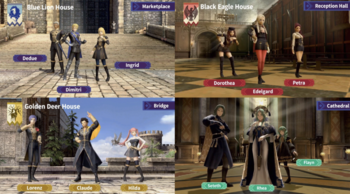
Nobles and commoners alike from across the continent of Fódlan come to Garreg Mach Monastery to attend the Officer's Academy and learn the art of war. Located centrally between the territories of the Adrestian Empire, the Holy Kingdom of Faerghus, and the Leicester Alliance, the Monastery is also the seat of power for the Church of Seiros, the religious leaders of Fódlan. Among the students that appear at the monastery include:
- Dimitri Alexandre Blaiddyd: Crown prince of the Holy Kingdom of Faerghus and leader of the Blue Lions house. He is the sole survivor of a tragedy that claimed the lives of his family. Appears at the Marketplace.
- Dedue Molinaro: A commoner from the Duscur region, retainer to Dimitri, and member of the Blue Lions house. Because of Duscur's role in the death of Faerghus's king, he has been forced to endure discrimination by many. Appears at the Marketplace.
- Ingrid Brandl Galatea: Scion of House Galatea, childhood friend of Dimitri, and member of the Blue Lions house. Because her family's status has declined, she works hard to excel as a knight. Appears at the Marketplace.
- The Gatekeeper: The cheerful gatekeeper who guards the gates of Garreg Mach Monastery. Appears at the Marketplace.
- Edelgard von Hresvelg: Crown princess of the Adrestian Empire and leader of the Black Eagles house. She is determined to prove herself worthy of becoming the next Emperor. Appears at the Reception Hall.
- Dorothea Arnault: An orphan from the streets of Enbarr, former diva of the Mittelfrank Opera Company, and member of the Black Eagles house. She is known to flirt with just about anyone, and hopes to eventually marry into wealth. Appears at the Reception Hall.
- Petra Macneary: Crown princess of Brigid, a vassal state of the Adrestian Empire, and member of the Black Eagles house. Although Brigid and the Empire used to be enemies, she works hard to bridge the gulf between them. Appears at the Reception Hall.
- Claude von Riegan: Scion of House Riegan, the leading noble family of the Leicester Alliance, and leader of the Golden Deer house. He is a notorious trickster, but cares deeply for his friends. Appears at the Bridge.
- Lorenz Hellman Gloucester: Scion of House Gloucester and member of the Golden Deer house. He prides himself on his noble heritage, often to the point of annoyance among his peers. Appears at the Bridge.
- Hilda Valentin Goneril: Daughter of House Goneril and member of the Golden Deer house. Though exceedingly brilliant, she is also known for being exceedingly lazy. Appears at the Bridge.
- Rhea: Archbishop of the Church of Seiros. She cares deeply for the students and staff of the academy and monastery, but can be unforgivingly harsh to her enemies. Appears at the Cathedral.
- Seteth: Right-hand adviser to Rhea, who handles administrative duties in the Church. He is meticulous and dedicated to serving Rhea, and is slow to trust anyone else. Appears at the Cathedral.
- Flayn: Seteth's younger sister, a mysterious girl who lives at the monastery. She is not often seen in the academy, but is unfailingly polite and friendly. Appears at the Cathedral.
- Ambiguously Brown: Dedue and Petra both have notably darker complexions than their peers. Justified, as both hail from the distant regions of Duscur and Brigid, respectively.
- Color-Coded for Your Convenience: Each of the three houses (and by extension, the countries of Fódlan) are color coded: red for the Black Eagles and Adrestria, blue for the Blue Lions and Faerghus, and yellow for the Golden Deer and Leicester.
- Everyone Calls Him "Barkeep": The Gatekeeper's name is never revealed. Everyone refers to him by his occupational title.
- Facial Markings: Petra has a violet tattoo underneath her eye. She also has markings on her arm and back that are concealed by her academy uniform. These markings are given to pay respect to Brigid's spirits.

Heihachi Mishima is a master of Mishima-Ryu Karate and one of the most notable presidents of the Mishima Zaibatsu, a MegaCorp specializing in military hardware. A believer in the idea that might makes right, he has his eyes set on global conquest, and will let nothing stand in his way — not even his own family! He appears on the Mishima Dojo stage in Ultimate. His younger self also appears as a Mii Fighter costume.
- Abusive Parents: One of the most infamous examples in video games. He threw Kazuya off a cliff as a child, and after Kazuya took vengeance upon Heihachi by doing the same, Heihachi responded by throwing Kazuya into a volcano...only for Kazuya to be revived. Heihachi also tried to kill his grandson, Jin Kazama, after deceiving him into helping him fight Ogre, and continues to clash with both him and Kazuya throughout the series.
- The Artifact: His Mii costume depicts his younger Tag Tournament 2 appearance because that was the latest Tekken to be released on consoles in 2015. When it was added to Ultimate in 2020, Tekken 7 was the latest one, and the costume was not updated to his older self to match.
- Ascended Extra: Went from only having a Mii Costume based off him to appearing in the background of Kazuya's stage.
- Badass Normal: His wife and the rest of his family have the Devil Gene, but Heihachi himself does not; his strength is almost entirely non-supernatural save for some Ki Attacks. Sakurai cited this as the reason he went with Kazuya instead of Heihachi, as he felt the Devil Gene powers could more easily fill out a more Smash-appropriate moveset.
- Big, Screwed-Up Family: Practically all of the drama surrounding the Mishima bloodline can be traced to him: he sealed his father, Jinpachi, in a mountain when he usurped the Mishima Zaibatsu; tossed his son, Kazuya, into a ravine (then later, into a volcano); tried to kill his grandson, Jin Kazama, after training him in the martial arts; and was forced to kill his wife, Kazumi, when she tried to kill him (on top of the fact that Kazuya and Jin both inherited the Devil Gene from her). He also adopted Lee Chaolan to serve as a rival to Kazuya, and sired an illegitimate son named Lars Alexanderson, both of whom would eventually side against the Mishimas.
- The Cameo: As a Mii Costume, a background character, and one of the characters Pac-Man can summon in his Namco Roulette.
- Cool Old Guy: He was 52 years old when he debuted in the original Tekken, but is a martial artist of great renown capable of holding his own against younger rivals.
- Evil Old Folks: He appears as his older self from Tekken 3-onwards, and suffice to say, he's not a nice person — being the CEO of a corrupt MegaCorp and an all-round abusive father.
- Irony: Before his appearances in Smash, Heihachi first appeared in Sony's attempt at a Smash-like crossover of their own.
- Jerkass: Unpleasant to just about everyone, except for his pet bear, Kuma, and his late wife, Kazumi Mishima.
- Mythology Gag: The reveals for his Mii Costumes in 4 and Ultimate contain several references to events in his home series:
- His Mii Costume in Smash 4 is first introduced at the end of Ryu's trailer, referencing Street Fighter X Tekken.
- In Ultimate, his Mii is first seen throwing Wolf into the volcano on Wuhu Island, a reference to him throwing Kazuya into a volcano at the end of Tekken 2.
- Then, his Mii is shown fighting Yoshi. This is likely a reference to Yoshimitsu, a ninja from both the Tekken games and the Soul Series, of which Heihachi and Link both guested in.
- Unusually Uninteresting Sight: In contrast to other background characters cheering on the fighters (namely those from the Mementos, King of Fighters Stadium, Garreg Mach, and Cloud Sea of Alrest stages), Heihachi will just sit and meditate with his back turned, only standing up and observing every once and a while and possibly jeering at the competitors, as if the chaos unfolding in his dojo isn't worth his time or attention.


Judd and Li'l Judd are a pair of rotund felines from Inkopolis who act as judges for the Inklings' Turf Wars. They appear on the Moray Towers stage to do what they do best, raising the flag for the current lead fighter.
- Combat Referee: Their job from their home series carries over to Smash.
- Last of His Kind: Judd is said to be the only being left from before the Mollusc Era.
- Our Clones Are Identical: Li'l Judd is implied to be a clone of Judd, and their statures are very similar.

The King of Fighters Tournament is heralded as one of the most famous martial arts tournaments in history, acting as a platform for warriors from any walk of life to challenge for the right to be the best in the world. Originally meant to be a simple one-on-one tournament as seen in the Fatal Fury games, the modern structure seen in its current namesake series has adopted a team format, where contestants form trios to advance the ranks. Among the fighters that appear at the arena include:
- Andy Bogard: Terry's younger brother, Andy is a gifted martial artist. While Terry trained under Tung Fu Rue, Andy trained in Japan under Hanzo Shiranui in the art of ninjutsu, alongside his eventual girlfriend Mai Shiranui.
- Joe Higashi: A boisterous Muay Thai master, Joe became fast friends with Terry and Andy during the first King of Fighters tournament, joining forces with them against Geese.
- Tung Fu Rue: Jeff Bogard and Geese Howard's former sensei who fights with Hakkyokuseiken and whose real name is unknown. He selected Jeff to succeed him, causing Geese to murder Jeff out of jealousy. He's wise, calm, and able to focus his chi to such a degree that his body surges in size and strength.
- Billy Kane: A London orphan who was taken in by Geese to become his right-hand man and personal tournament champion. Despite his criminal activities, he has a soft spot for his sister and abhors smoking, and he's deadly with his trademark three-sectional staff.
- Geese Howard: The most infamous criminal mastermind in Southtown's history, and the original host of the King of Fighters tournament, which Geese hosted to find a set of scrolls that would grant him immortality. He trained alongside Terry's father Jeff, but grew jealous when he was passed over as successor of Hakkyokuseiken and killed him in spite.
- Rock Howard: Geese Howard's own son was raised in relative peace by his mother until her unfortunate death from illness when he was seven. Terry took the boy under his wing, training him until the day Rock entered a King of Fighters tournament hosted by Kain R. Heinlein.
- Kim Kaphwan: Ever since his entry into Wolfgang Krauser's King of Fighters tournament, the "Crown Jewel of Taekwondo" has forged a strong friendship with Terry in his search for strong opponents to face. He fathered two sons, Kim Dong Hwan and Kim Jae Hoon, who have followed in his footsteps as practitioners of the art.
- Ryuji Yamazaki: A dangerous man with psychopathic tendencies, known for his criminal activities and love of money. Despite (or perhaps due to) his insanity, he's utterly immune to Orochi's corruptive influence, and he fights like a wild animal in matches.
- Blue Mary: A close confidant of Terry's, Mary Ryan works as a private detective ever since the death of her lover, Butch, who taught her to fight in the Sambo style.
- Athena Asamiya: Originally hailing from Psycho Soldier, she descends from the very original Athena and has been a mainstay of The King of Fighters series. She's a powerful psychic and moonlights as a J-pop performer.
- Kyo Kusanagi: First entering the tournaments as a high school student, Kyo is a practitioner of the Kusanagi martial arts. He comes from a long line of fighters gifted with powers over fire who have long stood guard over the world against the wicked god of destruction Orochi.
- Iori Yagami: Iori's rivalry with Kyo mirrors that of their families, the Kusanagi and the Yagami, the latter of whom were corrupted by Orochi. Iori's flames burn just as hot as Kyo's, but Orochi's influence leaves him susceptible of flying into a blind rage.
- Goro Daimon: A Judo practitioner with a heart nearly as big as he is tall, so don't let his gruff appearance fool you. He was introduced with Kyo and Benimaru Nikaido as the final member of the "Heroes" team.
- Chang Koehan: A Korean criminal who Kim Kaphwan took upon himself to rehabilitate, putting his immense strength closer to the side of good. Unfortunately, it didn't stick, and his ball and chain now have lawless intent once more.
- Choi Bounge: Chang's partner, almost never seen without his wicked clawed gloves. His rehabilitation had less of an effect even before they reverted to their criminal ways. He's quick, nimble, and sadistic to the core.
- Ralf Jones and Clark Still: The Ikari Warriors themselves. Mercenaries knowledgable of military warfare, they often take part in tournaments under the orders of Commander Heidern with his adopted daughter Leona, with the hot-blooded Ralf contrasting well with the cool-under-pressure Clark. Their fighting styles excude immense power in different ways; Ralf's hard-hitting rapid-fire punches and Clark's deadly wrestling throws make them a deadly combination to face in any fight.
- Ryo Sakazaki: Originally appearing in Art of Fighting, Ryo is a Southtown native and heir to the Kyokugenryu Karate dojo. He enters the tournaments in order to showcase the might of Kyokugenryu, in the hopes of attracting new students. Like Terry, his family has a sordid history with the crime lord Geese Howard.
- King: A bartender from Southtown known for having an androgynous appearance in her debut and putting her Muay Thai knowledge to work as a bouncer for Mr. Big. She now runs the Illusion bar and remains friendly with Ryo, who paid for her brother's leg surgery with the help of Robert Garcia.
- Yuri Sakazaki: Ryo's younger sister, Yuri was held hostage during the events of Art of Fighting. Once she was rescued, she also trained in Kyokugenryu to defend herself, but she never lost her optimistic attitude and desire for independence.
- Adaptational Badass: The fall Geese took in Terry's trailer was based off a Stage Fatality that would lead to him falling to death. Evidently, he's Made of Iron here, since he seems to have survived it.
- Adapted Out: Mai Shiranui, despite being one of the most popular SNK characters ever, was apparently banned from appearing in Smash Bros. Not because Sakurai felt she was too Fanservice focused, especially with characters like Bayonetta and Zero Suit Samus making the cut, but because CERO felt Mai's more revealing attire was a step too far.
- Anachronism Stew: Rock Howard is fully grown despite Terry having his younger design from the earlier Fatal Fury games (i.e. when Rock was a little kid and before Terry ever met him). Sakurai noted in the November 6th, 2019 stream that continuity anachronisms like this are already common in Super Smash Bros. Becomes
 Hilarious in Hindsight when you consider Rock appeared alongside Terry in his classic appearance in The King of Fighters XV.
Hilarious in Hindsight when you consider Rock appeared alongside Terry in his classic appearance in The King of Fighters XV. - Disney Villain Death: Terry's reveal trailer shows Geese Howard once again falling to his death while trying to grab the Smash invitation letter. What makes this time unique is that he was not shoved off by one of the heroes — and he would have died even if he had grabbed the letter.
- The Dividual: Played With to a degree. Ralf and Clark are introduced together in Terry's representation as the Ikari Warriors representatives, but both can appear separately, albeit rarely, at random unless a song representing their team is playing. Ditto for Chang and Choi.
- Evil Laugh: Geese Howard can be seen (but not heard) doing this whenever he is in the background. Iori gives off a mad cackle in Terry's trailer.
- Genki Girl: As shown in the collage here, Athena and Yuri periodically strike poses that testify to their high-spirited enthusiasm.
- Head Swap: Ralf and Clark are depicted with their original The King of Fighters designs in which they were this.
- Leitmotif: Some of the characters' themes from their respective games show up as part of the KOF Stadium's music tracks, and specific characters will show up if their theme is playing. This does not apply to all fighters, as some like Rock and Mary do not have themes associated with them on the stage's play
- Mythology Gag:
- Their appearances in the background of their stage reference how inactive teammates stayed on the sidelines in older King of Fighters titles, down to (most characters) copying the same poses they have while idle. SNK games are also full of cameos like these from its characters that aren't playable.
- Rock can be seen clutching his hand in pain while it is glowing with purple energy, referencing the unique win poses he has where he would do the same thing if he wins a round with the supers he's directly inherited from Geese, like the Raging Storm or Neo Deadly Rave.
- Stroke the Beard: Tung Fu Rue does this whenever he's on the stage.
Various mobs that appear in the background of the Minecraft World stage including cows, pigs, chickens, villagers, creepers, skeletons, spiders, Endermen, and zombies.
- Villagers: Large-nosed Ambiguously Human characters that populate villages across a Minecraft world.
- Cows: Common four-legged bovine animals. Can be tamed, milked, bred, or killed for beef and leather.
- Pigs: Common docile pink mammals. Can be tamed, bred and ridden, or killed for pork.
- Chickens: Common flightless birds. Can lay eggs for the player to collect, or be killed for their meat.
- Creepers: Sinister green creatures that will hiss and explode upon provocation. See more in their individual folder above.
- Skeletons: Animated skeletons armed with bows and arrows. They burst into flame when exposed to sunlight and can occasionally be found riding on the backs of spiders.
- Zombies: Undead humanoid creatures. One of them is playable as a skin for Steve.
- Spiders: Giant arachnids that reside in dark caves and venture outside at night. They can occasionally be found giving skeletons a ride.
- Endermen: Tall, dark, mysterious creatures from the End that can teleport, move around blocks and become incredibly dangerous when provoked. One is playable as a skin for Steve.
- Your Size May Vary: The Endermen in the background of Minecraft World are properly scaled, unlike the playable skin for Steve that is sized to his regular proportions.
A mysterious old hermit who is the sole inhabitant of the Great Plateau. He occasionally glides to the top of the Great Plateau Tower during battle.
- The Cameo: His in-game appearance is limited to a background role in the Great Plateau Tower stage, where he occasionally glides to and away from the platform or in the background. He doesn't even get a spirit.
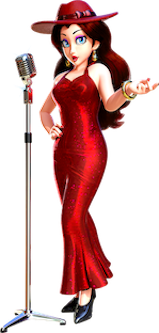
Mario's first love interest from all the way back in the original Donkey Kong. After a few bit appearances in the Mario Vs. Donkey Kong series, she appears in Super Mario Odyssey as the mayor of New Donk City.
- Running Gag: One of her dance animations shows her punching upward. Several of Ultimate's fighter videos (e.g. Mario's, Isabelle's) have the characters doing similar moves as she does this.
- Theme Music Power-Up: Touching her on the stages has her sing "Jump Up, Super Star" during the battle.
- Variable Mix: If "Jump Up, Super Star" is playing on the New Donk City Hall stage, she won't start singing along unless a fighter touches her. Other songs with Performance versions will also be affected by which band members were interacted with, though all of them also include a special version that played the entire song from the start.
Banjo and Kazooie's home of Spiral Mountain, an idyllic region on the Isle O'Hags, is inhabited by several characters they've encountered in their journeys:
- Buzzbombs: Aggressive dragonfly enemies that appeared in areas such as Bubblegloop Swamp and Click Clock Wood.
- Jinjos: Colorful, flying creatures with long snouts who rewarded Banjo and Kazooie for rescuing them. See their section under Summoned Characters above for more.
- Bottles: A nearsighted mole who taught the duo many of their unique moves. He was once killed by Grunty upon her return, but got better within a week. When that happened, his brother Jamjars took his place instead. Bottles pops out of his molehills across Spiral Mountain.
- Gruntilda Winkybunion: The duo's Arch-Enemy, this rhyme-loving witch kidnapped Banjo's sister Tooty with the intent of draining the young bear's beauty for herself. Even after being defeated and left as an undead skeleton, she still sought ways to restore her flesh and get revenge on Banjo and Kazooie. She is seen circling around the stage on her broomstick, with her flesh restored to boot.
- Mumbo Jumbo: A shaman who once mentored Grunty until she spitefully turned his head into a skull. He uses his magic to help Banjo and Kazooie, whether by giving them transformations or by going out into the world himself to change the landscape with his spells. He is occasionally seen warping across the stage.
- Tooty: Banjo's younger sister who was kidnapped by Gruntilda in an attempt to steal her beauty (which actually happens in the Game Over scene), she was rescued by Banjo and Kazooie, only to disappear from the series. She can be seen in the distance running around the area.
- Accessory-Wearing Cartoon Animal: Bottles has glasses and a vest but is otherwise naked.
- The Bus Came Back: This is Tooty's first appearance since the original Banjo-Kazooie. Her only other appearance was as a Face on a Milk Carton in Banjo-Tooie.
- Evil Laugh: Gruntilda's iconic cackle can occasionally be heard.
- Eye Scream: Mumbo can sometimes be seen juggling his own eyeballs before placing them back in their sockets, something he could do in Nuts & Bolts.
- Skull for a Head: Mumbo's head is simply a skull with a pair of eyes.
- Vain Sorceress: In case you weren't already familiar with Gruntilda's vain character from the Banjo-Kazooie games, the fact that her massive Lair overlooking Spiral Mountain is a facsimile of her head should provide a hint.
- Wicked Witch: Gruntilda is nearly identical-looking to the Trope Namer, albeit much uglier, and is appropriately the vain Big Bad of her home series. She even has a Flying Broomstick with eyes.
The various Titans that make up the landmass of Alrest. Each one is home to a different country. They all appear as background characters in the Cloud Sea of Alrest stage.
- Argentum: A group of Titans owned by the Argentum Trade Guild. The biggest one, Goldmouth, resembles a flying blimp-like whale.
- Gormott: A Titan that resembles a giraffe or a deer. It boasts lush greenery and abundant natural resources, which has attracted the attention of the Empire of Mor Ardain in the past.
- Uraya: A giant whale-like Titan. It has a vast cave-like system inside its body, where most of its residents, The Kingdom of Uraya live. Its featured on the boxart of Xenoblade Chronicles 2.
- Mor Ardain: A Titan that has a humanoid shape. This Titan has a very hot climate and it is becoming increasingly harder to grow food. It is actually nearing its death and its left arm has already broken off.
- Indol: A Titan ruled by the Indoline Praetorium. It resembles a giant flying dragon, who its residents revere.
- Genbu note : A Titan the resembles a gigantic sea turtle. Its the only Titan to have an arctic-like environment, but apparently this isn't natural.
- Bilingual Bonus:
- Argentum's name means "silver" in Latin, but "argentum" is also a word that means "money".
- Gormott's name comes from the French word "gourmand", or a gluttonous person.
- Uraya's name is derived from the Japanese word "urayamashi", which means "to be envious".
- Mor Ardain's name is a play on the Gaelic words for "great arrogance".
- Gratuitous Latin: All of their names in the Japanese dub are the Latin words for the Seven Deadly Sins. Argentum is the only one who has a Latin name in the English dub.
- Monstrous Scenery: Their country-sized forms periodically walk or fly across the far background of the stage.
- Mythology Gag: They appear in the same order as they're visited in the original game.
- Theme Naming: They're each named after one of the seven deadly sins. Genbu is the exception to this, but the Kingdom of Tantal is named after lust.
- Token Human: Mor Ardain is the only humanoid Titan.
- World Shapes: Most of the titans are continents unto themselves, swimming in or walking through the vast cloudsea.
Liquid Metal Slime: Dragon Quest II [NES], (1987)
Cetacea: Dragon Quest XI [PS4/3DS], (2018)
The platform that carries the fighters around Yggdrasil's Altar also brings them close to various creatures that have appeared across the Dragon Quest series
- Slime: A smiling, gooey monster that serves as a common low-level threat to various heroes.
- Liquid Metal Slime: An extremely rare variety of Slime that is often seen as a valuable source of experience.
- Cetacea: A large flying whale-like creature who helped both the Luminary and his ancient predecessor Erdwin by ferrying them and their companions on her back across the sky.
- The Cameo: They play little to no role in the battles, largely appearing as background decoration.
- Flying Seafood Special: Cetacea resembles a flying whale with bird wings.
- Metal Slime: The Liquid Metal Slime, much like in the original game, appears very rarely and quickly leaves the stage after appearing.






